2023年中考英语名词性从句课件(共34张PPT)
文档属性
| 名称 | 2023年中考英语名词性从句课件(共34张PPT) |  | |
| 格式 | zip | ||
| 文件大小 | 118.5KB | ||
| 资源类型 | 教案 | ||
| 版本资源 | 人教新目标(Go for it)版 | ||
| 科目 | 英语 | ||
| 更新时间 | 2022-07-28 11:40:32 | ||
图片预览


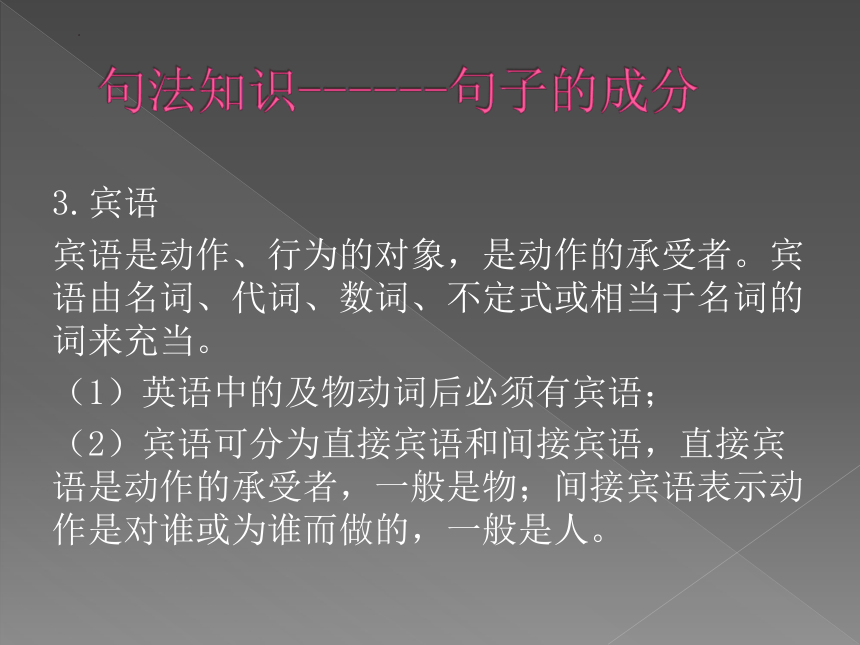
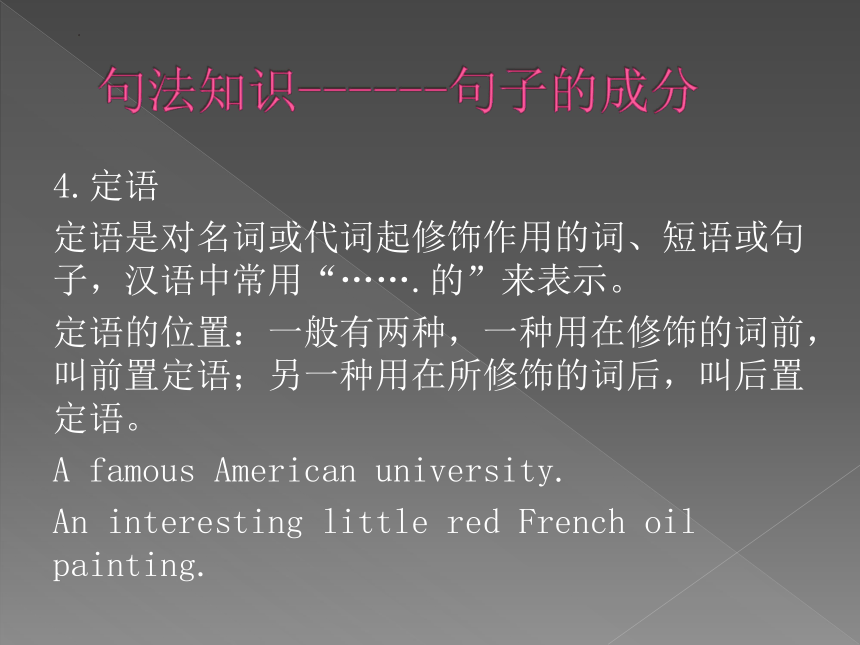
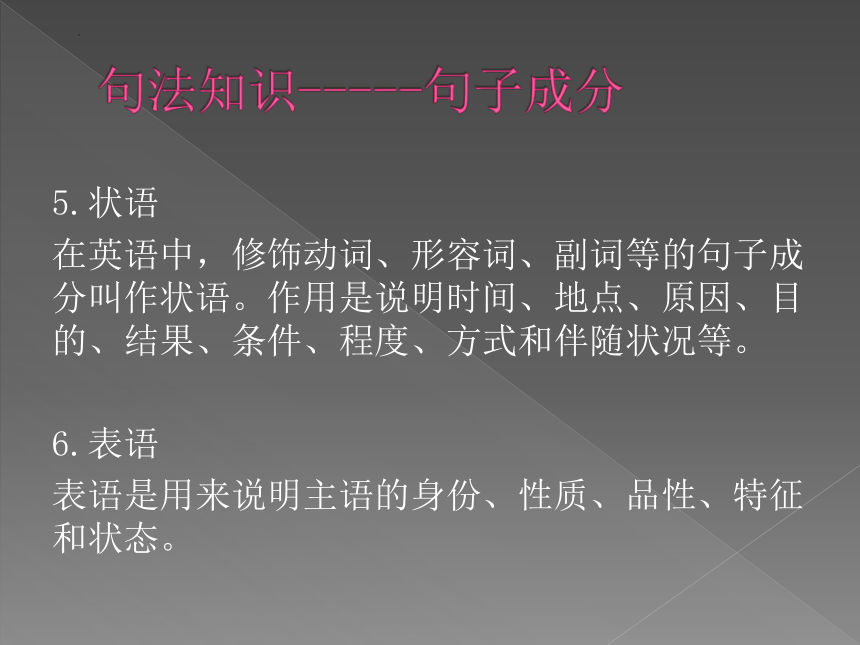
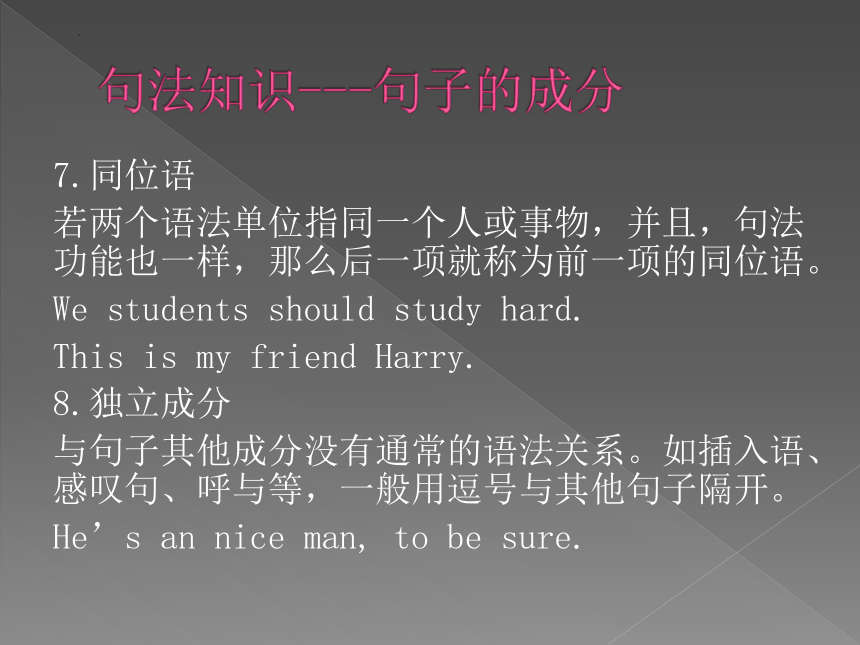
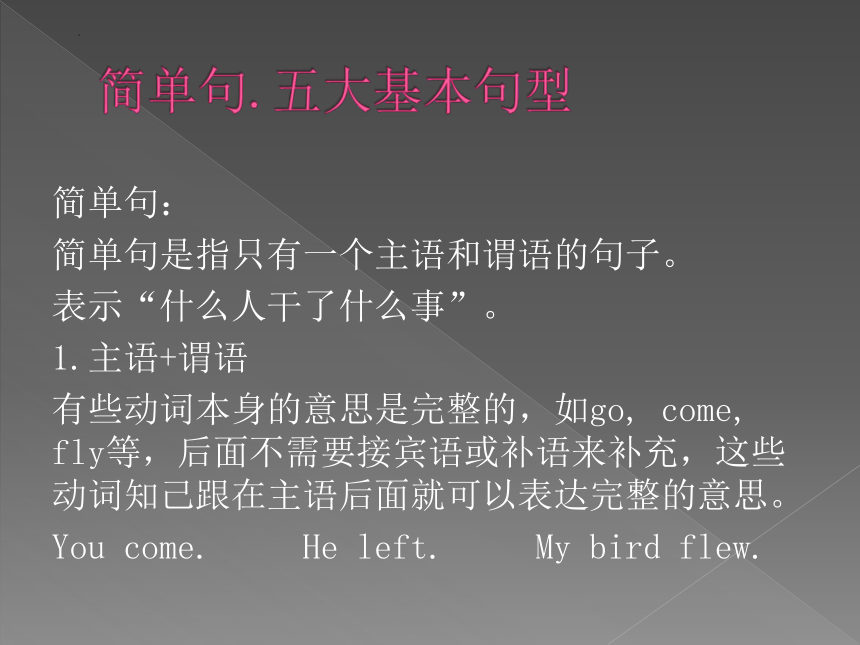
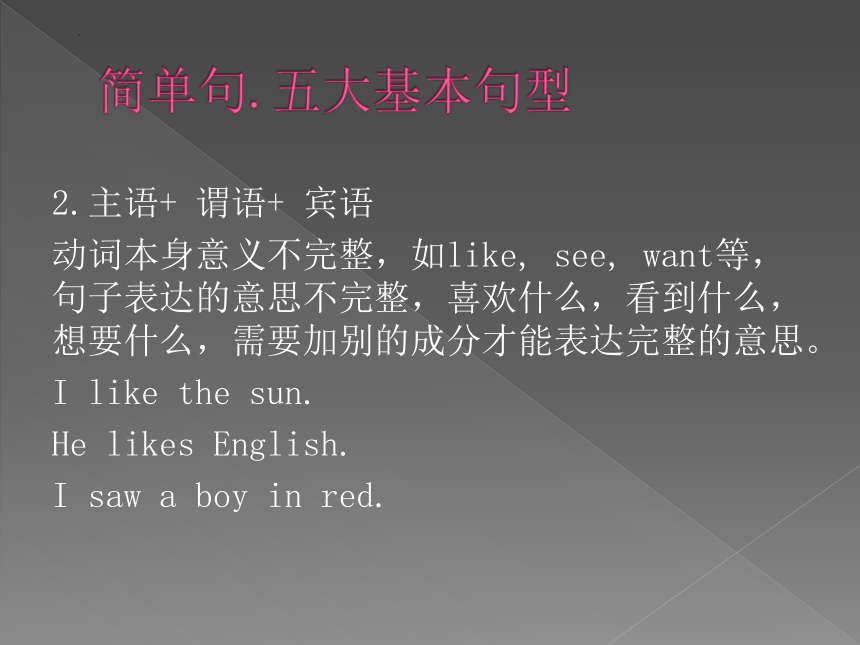
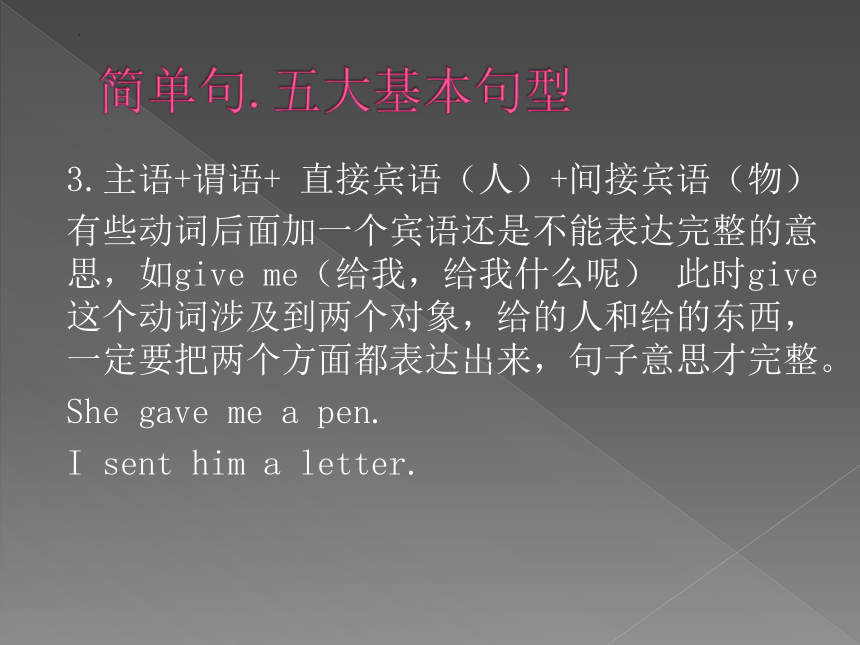
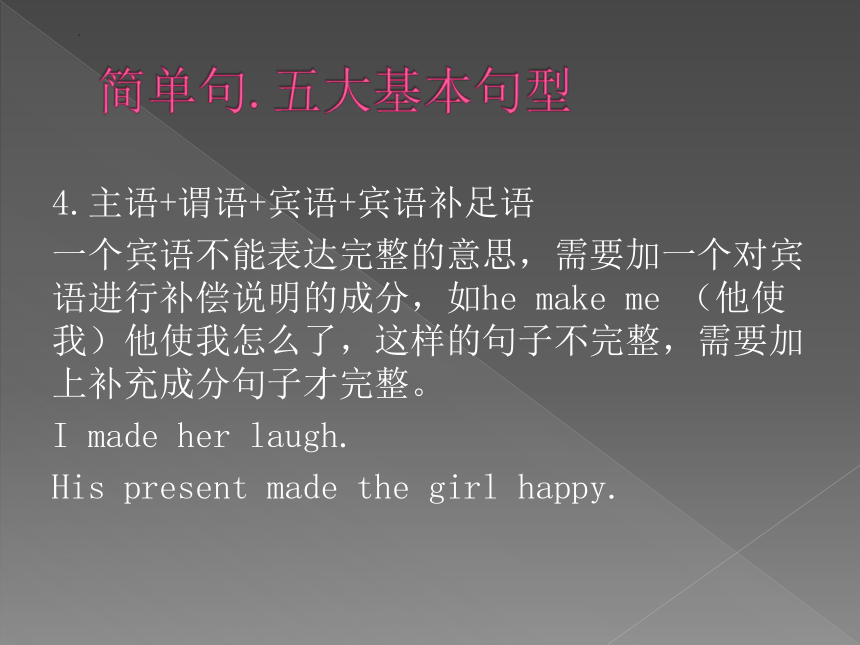
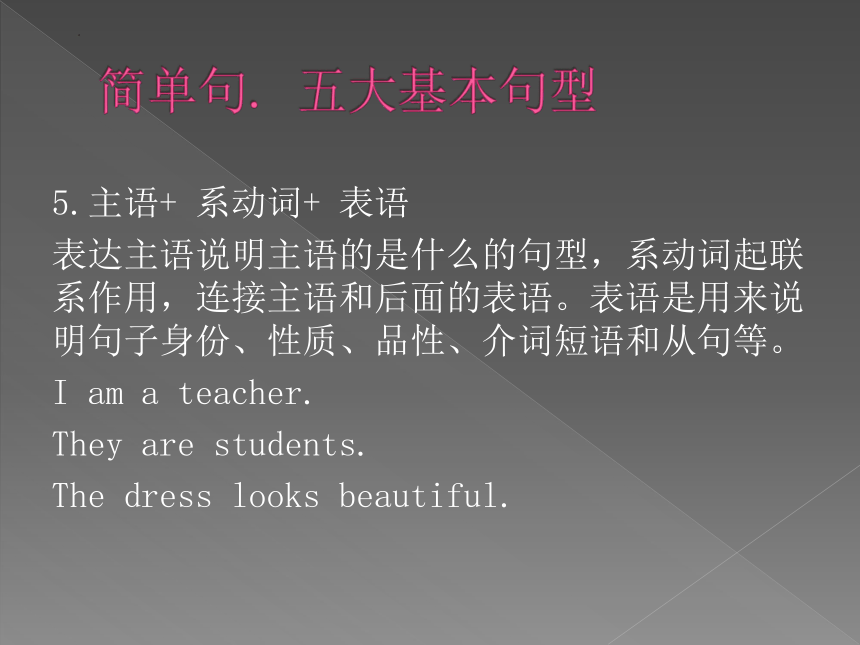
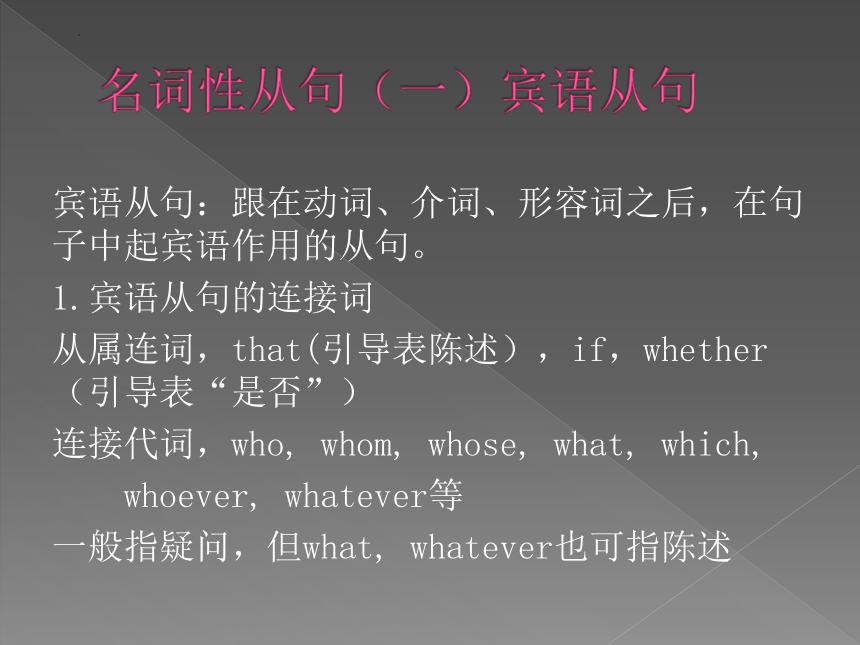
文档简介
(共34张PPT)
语法专题
初中英语语法
Claudia my
句法知识-----句子的成分
1.主语
主语是句子陈述的对象,表示句子说的是什么。主语是执行句子的行为或动作的主体,可以用这些词类来充当:名词、代词、数词、动名词、动词不定式或不定式短语、从句等。
2.谓语
谓语是对主语动作或状态的陈述说明,指出“做什么”“是什么”或“怎么样”,一般谓语主语之后,谓语动词能够体现出不同的时态和语态。
句法知识------句子的成分
3.宾语
宾语是动作、行为的对象,是动作的承受者。宾语由名词、代词、数词、不定式或相当于名词的词来充当。
(1)英语中的及物动词后必须有宾语;
(2)宾语可分为直接宾语和间接宾语,直接宾语是动作的承受者,一般是物;间接宾语表示动作是对谁或为谁而做的,一般是人。
句法知识------句子的成分
4.定语
定语是对名词或代词起修饰作用的词、短语或句子,汉语中常用“…….的”来表示。
定语的位置:一般有两种,一种用在修饰的词前,叫前置定语;另一种用在所修饰的词后,叫后置定语。
A famous American university.
An interesting little red French oil painting.
句法知识-----句子成分
5.状语
在英语中,修饰动词、形容词、副词等的句子成分叫作状语。作用是说明时间、地点、原因、目的、结果、条件、程度、方式和伴随状况等。
6.表语
表语是用来说明主语的身份、性质、品性、特征和状态。
句法知识---句子的成分
7.同位语
若两个语法单位指同一个人或事物,并且,句法功能也一样,那么后一项就称为前一项的同位语。
We students should study hard.
This is my friend Harry.
8.独立成分
与句子其他成分没有通常的语法关系。如插入语、感叹句、呼与等,一般用逗号与其他句子隔开。
He’s an nice man, to be sure.
简单句.五大基本句型
简单句:
简单句是指只有一个主语和谓语的句子。
表示“什么人干了什么事”。
1.主语+谓语
有些动词本身的意思是完整的,如go, come, fly等,后面不需要接宾语或补语来补充,这些动词知己跟在主语后面就可以表达完整的意思。
You come. He left. My bird flew.
简单句.五大基本句型
2.主语+ 谓语+ 宾语
动词本身意义不完整,如like, see, want等,句子表达的意思不完整,喜欢什么,看到什么,想要什么,需要加别的成分才能表达完整的意思。
I like the sun.
He likes English.
I saw a boy in red.
简单句.五大基本句型
3.主语+谓语+ 直接宾语(人)+间接宾语(物)
有些动词后面加一个宾语还是不能表达完整的意思,如give me(给我,给我什么呢) 此时give 这个动词涉及到两个对象,给的人和给的东西,一定要把两个方面都表达出来,句子意思才完整。
She gave me a pen.
I sent him a letter.
简单句.五大基本句型
4.主语+谓语+宾语+宾语补足语
一个宾语不能表达完整的意思,需要加一个对宾语进行补偿说明的成分,如he make me (他使我)他使我怎么了,这样的句子不完整,需要加上补充成分句子才完整。
I made her laugh.
His present made the girl happy.
简单句. 五大基本句型
5.主语+ 系动词+ 表语
表达主语说明主语的是什么的句型,系动词起联系作用,连接主语和后面的表语。表语是用来说明句子身份、性质、品性、介词短语和从句等。
I am a teacher.
They are students.
The dress looks beautiful.
名词性从句(一)宾语从句
宾语从句:跟在动词、介词、形容词之后,在句子中起宾语作用的从句。
1.宾语从句的连接词
从属连词,that(引导表陈述),if,whether(引导表“是否”)
连接代词,who, whom, whose, what, which,
whoever, whatever等
一般指疑问,但what, whatever也可指陈述
名词性从句(一)宾语从句
连接副词, when, where, why ,how, whenever,
however等
Do you know that two college students created an “online marketplace” on campus?
你知道两个美国大学生在校内创办了一个网上市场。
This book will show you what the best CEOs should know.
这本书会告诉你最好的执行总裁应该了解什么。
名词性从句(一)宾语从句
宾语从句的语序
宾语从句的语序为陈述语序,即“主语+谓语”的顺序。
尤其要注意whether, if 和wh-疑问词引导的宾语从句的语序。
He asked me what I did yesterday afternoon.
Do you know why winter is colder than summer
名词性从句(一)宾语从句
I think , I believe 等后接宾语从句时,若否定的是后面的从句,一般将主句动词改为否定形式,而从句仍用肯定形式,与汉语习惯不同。
I don’t think you like sports.
I don’t believe she will take part in the English club.
宾语从句的时态
宾语从句的时态必须和主句呼应)
(1)当主句谓语是现在或将来时态时,从句谓语不受主句谓语时态的影响,可以按需要使用任何时态。
I hear he’ll be back in a few days.(一般将来时)
I hear he came back a few days ago.(一般过去时)
(2)当主句谓语是过去时态时,从句中的时态一般为过去的某种时态,以便保持与主语谓语动词的时态一致。
宾语从句的时态
She said she was much better than before.
(一般过去时)
She said she was reading a book at seven yesterday.
(过去进行时)
He said (that) he was going to take care of the baby.
(过去将来时)
宾语从句的时态
3.当主句谓语是过去时态,而宾语从句叙述某一客观事实、真理时,宾语从句的时态用一般现在时。
They said that the earth is round.
他们说地球是圆的。
名词性从句.宾语从句
用it作形式宾语的宾语从句
1.动词find, think, consider, make, believe等后有宾语补足语时,需要用it作形式宾语且将that 引导的宾语从句后置。
I think it necessary that we drink some water every day.
2.有些动词如hate, like, appreciate, depend on, appreciate, see to等后跟宾语从句时习惯用it作形式宾语。
I hate it when they talk with their mouth full of food.
名词性从句. 主语从句
用作主语的从句叫主语从句。主语从句要用陈述语序,且主语从句后的谓语动词要用第三人称单数,引导主语从句的连接词有从属连词that, whether等,连接代词who, what, which等;连接副词when, where, how , why等。
1.that引导的主语从句时只起引导作用,没有任何实际意义,在主语从句中不充当任何成分,但不能省略。
That she left him cut him to the heart.
That the earth moves around the sun is true.
有时为避免句子头重脚轻,常用it做形式主语,代替主语从句放在句首,而把主语从句置于句末。
名词性从句.主语从句
2.Whether引导的主语从句放在句首,句末都可以。
意为“是否”,只起连接作用,不充当任何成分,置于句首时用“whether”引导,置于句末时“whether/if”都可以。
Whether it will please them is not easy to say.
if引导的主语从句只能放在句末,前面要用it作形式主语。
It is uncertain whether/if it will rain.
It is not clear whether/if she will come.
3.主语从句可以前置,也可以后置。用it作形式主语时,必须把主语从句后置,常用句型有以下几种;
It +be+表语(n/adj/been) +主语从句
It is still uncertain whether he is coming or not.
名词性从句---主语从句
it 作形式主语的结构
1.It is/was +形容词+that 从句
It is impossible that you can finish this work in two hours.
2. It is/was +名词+that从句
It’s a pity that you lost your watch.
3.It is/was +不及物动词+ that从句
It seems that the film is not very popular.
It作形式主语和it 引导的强调句区别
It 作形式主语时,主要是为了平衡句子结构,主语从句的连接词没有变化。
It is strange that he knows nothing about it.
It引导的强调句结构为:
It is/was+被强调的部分+that 从句,是为了对句中的某一部分进行强调,无论强调的是什么成分,都可用连词that。被强调部分指人时也可用who/whom.
名词性从句---主语从句
Wh-引导的主语从句
(1)连接代词 what who whom whose whatever whoever whomever
(2)连接副词 when where why how however whenever wherever
What we need is more money.
Who will go makes no difference.
Whom we must serve is a question.
Where we will have our holiday is still unknown.
Whatever you did is right.
名词性从句—— 表语从句
表语从句,在复合句中在系动词之后作表语的从句。表语从句和主语指一个内容,对主语进行解释说明,使主语的内容更加具体化。 表语从句的连接词主要有从属连词whether, that;连接代词what, who , which等;连接副词when, where, why 等。
If不能引导表语从句
1.That引导表语从句时,只起连接作用,在从句中不作成分。That无实际意义,一般不省略,但在口语中有时可以省略。
The trouble is that I have lost his address.
名词性从句----表语从句
主语是表示“建议、要求、命令”的词时,如suggestion, advice, order, demand等,表语从句的谓语动词常用“should+动词原形”,should可以省略。
My suggestion is that we (should) tell him.
2.Whether 意为“是否”,在句中不作成分,不可省略。
The question is whether the film is worth seeing.
What I was uncertain about was whether they could do the work well.
名词性从句-----表语从句
3.wh-引导的表语从句
Wh类连接词引导的从句作表语时,通常有一定的实际意义,连接代词在从句中作主语、宾语、表语、定语等成分,连接词在从句中作状语。
That ‘s where I first met her.
This is why I think my happiest days will be in the future.
That’s what we should do.
what在表语从句中作宾语时 ,不可省略。
名词 性从句----表语从句
4.as if/ as though, because 引导的表语从句
此类词引导的表语从句常跟在特定的动词后面,如seem, appear, as though, look ,taste 等
(1)as if /as though 引导的表语从句,可用陈述语序,也可用虚拟语气。
It seems as if you are from the south of the United States.
(与事实相符)
He looks as if he were from the Mars.(与事实不符)
名词性从句----表语从句
(2)because引导的表语从句
主句主语不能用reason.
That’s because you can’t appreciate music.
If I’m a bit sleepy, it’s because I was up all night.
名词性从句----同位语从句
定义:同位语从句指的是在复合句中充当同位语的从句,属于名词性从句范畴,同位语从句用来对其前面的抽象名词进行解释说明。
一、用法
一个名词(或其他形式)对另一个名词或代词进行修饰,限定或说明,这个名词就是同位语。同位语与被它限定的词的格式要一致,并常常紧挨在一起。同位语从句即重复说明一个称谓或事件的从句。
名词性从句---同位语从句
1.名词作同位语
Mr. Wang , my child’s teacher, will be visiting us on Tuesday.
在这里Mr. Wang就是被“my child’s teacher”修饰
2.短语作同位语
I, the oldest girl in the family, always had to care of the other children.
名词性从句---同位语从句
3.直接引语作同位语
But now, the question comes to their minds, “Did she die young because she was a clone ”
4.句子作同位语
The girl were surprised at the fact that ocean ships can sail up the Great lakes.
巨大的海轮可以开到五大湖,让女孩感到吃惊。
名词性从句---同位语从句
固定用法:同位语部分是个句子,就是同位语从句,这种用法比较固定。
1.在复合句中用作同位语的从句叫同位语从句。它一般跟在某些名词后面,用以说明该名词表示的具体内容。
I heard the news that our team had won.
2.可以跟同位语从句的名词通常有:news, idea, promise, question, doubt, thought, hope, message, suggestion, words.即抽象名词。
名词性从句---同位语从句
3.英语中引导同位语从句的词通常有连词that, whether ;连接代词what, who ;连接副词how, when, where等
if 不能引导同位语从句
He must answer the question whether he agrees with it or not.
4.有时同位语不紧跟在说明的名词后面
The thought came to him that maybe the enemy had fled the city.
语法专题
初中英语语法
Claudia my
句法知识-----句子的成分
1.主语
主语是句子陈述的对象,表示句子说的是什么。主语是执行句子的行为或动作的主体,可以用这些词类来充当:名词、代词、数词、动名词、动词不定式或不定式短语、从句等。
2.谓语
谓语是对主语动作或状态的陈述说明,指出“做什么”“是什么”或“怎么样”,一般谓语主语之后,谓语动词能够体现出不同的时态和语态。
句法知识------句子的成分
3.宾语
宾语是动作、行为的对象,是动作的承受者。宾语由名词、代词、数词、不定式或相当于名词的词来充当。
(1)英语中的及物动词后必须有宾语;
(2)宾语可分为直接宾语和间接宾语,直接宾语是动作的承受者,一般是物;间接宾语表示动作是对谁或为谁而做的,一般是人。
句法知识------句子的成分
4.定语
定语是对名词或代词起修饰作用的词、短语或句子,汉语中常用“…….的”来表示。
定语的位置:一般有两种,一种用在修饰的词前,叫前置定语;另一种用在所修饰的词后,叫后置定语。
A famous American university.
An interesting little red French oil painting.
句法知识-----句子成分
5.状语
在英语中,修饰动词、形容词、副词等的句子成分叫作状语。作用是说明时间、地点、原因、目的、结果、条件、程度、方式和伴随状况等。
6.表语
表语是用来说明主语的身份、性质、品性、特征和状态。
句法知识---句子的成分
7.同位语
若两个语法单位指同一个人或事物,并且,句法功能也一样,那么后一项就称为前一项的同位语。
We students should study hard.
This is my friend Harry.
8.独立成分
与句子其他成分没有通常的语法关系。如插入语、感叹句、呼与等,一般用逗号与其他句子隔开。
He’s an nice man, to be sure.
简单句.五大基本句型
简单句:
简单句是指只有一个主语和谓语的句子。
表示“什么人干了什么事”。
1.主语+谓语
有些动词本身的意思是完整的,如go, come, fly等,后面不需要接宾语或补语来补充,这些动词知己跟在主语后面就可以表达完整的意思。
You come. He left. My bird flew.
简单句.五大基本句型
2.主语+ 谓语+ 宾语
动词本身意义不完整,如like, see, want等,句子表达的意思不完整,喜欢什么,看到什么,想要什么,需要加别的成分才能表达完整的意思。
I like the sun.
He likes English.
I saw a boy in red.
简单句.五大基本句型
3.主语+谓语+ 直接宾语(人)+间接宾语(物)
有些动词后面加一个宾语还是不能表达完整的意思,如give me(给我,给我什么呢) 此时give 这个动词涉及到两个对象,给的人和给的东西,一定要把两个方面都表达出来,句子意思才完整。
She gave me a pen.
I sent him a letter.
简单句.五大基本句型
4.主语+谓语+宾语+宾语补足语
一个宾语不能表达完整的意思,需要加一个对宾语进行补偿说明的成分,如he make me (他使我)他使我怎么了,这样的句子不完整,需要加上补充成分句子才完整。
I made her laugh.
His present made the girl happy.
简单句. 五大基本句型
5.主语+ 系动词+ 表语
表达主语说明主语的是什么的句型,系动词起联系作用,连接主语和后面的表语。表语是用来说明句子身份、性质、品性、介词短语和从句等。
I am a teacher.
They are students.
The dress looks beautiful.
名词性从句(一)宾语从句
宾语从句:跟在动词、介词、形容词之后,在句子中起宾语作用的从句。
1.宾语从句的连接词
从属连词,that(引导表陈述),if,whether(引导表“是否”)
连接代词,who, whom, whose, what, which,
whoever, whatever等
一般指疑问,但what, whatever也可指陈述
名词性从句(一)宾语从句
连接副词, when, where, why ,how, whenever,
however等
Do you know that two college students created an “online marketplace” on campus?
你知道两个美国大学生在校内创办了一个网上市场。
This book will show you what the best CEOs should know.
这本书会告诉你最好的执行总裁应该了解什么。
名词性从句(一)宾语从句
宾语从句的语序
宾语从句的语序为陈述语序,即“主语+谓语”的顺序。
尤其要注意whether, if 和wh-疑问词引导的宾语从句的语序。
He asked me what I did yesterday afternoon.
Do you know why winter is colder than summer
名词性从句(一)宾语从句
I think , I believe 等后接宾语从句时,若否定的是后面的从句,一般将主句动词改为否定形式,而从句仍用肯定形式,与汉语习惯不同。
I don’t think you like sports.
I don’t believe she will take part in the English club.
宾语从句的时态
宾语从句的时态必须和主句呼应)
(1)当主句谓语是现在或将来时态时,从句谓语不受主句谓语时态的影响,可以按需要使用任何时态。
I hear he’ll be back in a few days.(一般将来时)
I hear he came back a few days ago.(一般过去时)
(2)当主句谓语是过去时态时,从句中的时态一般为过去的某种时态,以便保持与主语谓语动词的时态一致。
宾语从句的时态
She said she was much better than before.
(一般过去时)
She said she was reading a book at seven yesterday.
(过去进行时)
He said (that) he was going to take care of the baby.
(过去将来时)
宾语从句的时态
3.当主句谓语是过去时态,而宾语从句叙述某一客观事实、真理时,宾语从句的时态用一般现在时。
They said that the earth is round.
他们说地球是圆的。
名词性从句.宾语从句
用it作形式宾语的宾语从句
1.动词find, think, consider, make, believe等后有宾语补足语时,需要用it作形式宾语且将that 引导的宾语从句后置。
I think it necessary that we drink some water every day.
2.有些动词如hate, like, appreciate, depend on, appreciate, see to等后跟宾语从句时习惯用it作形式宾语。
I hate it when they talk with their mouth full of food.
名词性从句. 主语从句
用作主语的从句叫主语从句。主语从句要用陈述语序,且主语从句后的谓语动词要用第三人称单数,引导主语从句的连接词有从属连词that, whether等,连接代词who, what, which等;连接副词when, where, how , why等。
1.that引导的主语从句时只起引导作用,没有任何实际意义,在主语从句中不充当任何成分,但不能省略。
That she left him cut him to the heart.
That the earth moves around the sun is true.
有时为避免句子头重脚轻,常用it做形式主语,代替主语从句放在句首,而把主语从句置于句末。
名词性从句.主语从句
2.Whether引导的主语从句放在句首,句末都可以。
意为“是否”,只起连接作用,不充当任何成分,置于句首时用“whether”引导,置于句末时“whether/if”都可以。
Whether it will please them is not easy to say.
if引导的主语从句只能放在句末,前面要用it作形式主语。
It is uncertain whether/if it will rain.
It is not clear whether/if she will come.
3.主语从句可以前置,也可以后置。用it作形式主语时,必须把主语从句后置,常用句型有以下几种;
It +be+表语(n/adj/been) +主语从句
It is still uncertain whether he is coming or not.
名词性从句---主语从句
it 作形式主语的结构
1.It is/was +形容词+that 从句
It is impossible that you can finish this work in two hours.
2. It is/was +名词+that从句
It’s a pity that you lost your watch.
3.It is/was +不及物动词+ that从句
It seems that the film is not very popular.
It作形式主语和it 引导的强调句区别
It 作形式主语时,主要是为了平衡句子结构,主语从句的连接词没有变化。
It is strange that he knows nothing about it.
It引导的强调句结构为:
It is/was+被强调的部分+that 从句,是为了对句中的某一部分进行强调,无论强调的是什么成分,都可用连词that。被强调部分指人时也可用who/whom.
名词性从句---主语从句
Wh-引导的主语从句
(1)连接代词 what who whom whose whatever whoever whomever
(2)连接副词 when where why how however whenever wherever
What we need is more money.
Who will go makes no difference.
Whom we must serve is a question.
Where we will have our holiday is still unknown.
Whatever you did is right.
名词性从句—— 表语从句
表语从句,在复合句中在系动词之后作表语的从句。表语从句和主语指一个内容,对主语进行解释说明,使主语的内容更加具体化。 表语从句的连接词主要有从属连词whether, that;连接代词what, who , which等;连接副词when, where, why 等。
If不能引导表语从句
1.That引导表语从句时,只起连接作用,在从句中不作成分。That无实际意义,一般不省略,但在口语中有时可以省略。
The trouble is that I have lost his address.
名词性从句----表语从句
主语是表示“建议、要求、命令”的词时,如suggestion, advice, order, demand等,表语从句的谓语动词常用“should+动词原形”,should可以省略。
My suggestion is that we (should) tell him.
2.Whether 意为“是否”,在句中不作成分,不可省略。
The question is whether the film is worth seeing.
What I was uncertain about was whether they could do the work well.
名词性从句-----表语从句
3.wh-引导的表语从句
Wh类连接词引导的从句作表语时,通常有一定的实际意义,连接代词在从句中作主语、宾语、表语、定语等成分,连接词在从句中作状语。
That ‘s where I first met her.
This is why I think my happiest days will be in the future.
That’s what we should do.
what在表语从句中作宾语时 ,不可省略。
名词 性从句----表语从句
4.as if/ as though, because 引导的表语从句
此类词引导的表语从句常跟在特定的动词后面,如seem, appear, as though, look ,taste 等
(1)as if /as though 引导的表语从句,可用陈述语序,也可用虚拟语气。
It seems as if you are from the south of the United States.
(与事实相符)
He looks as if he were from the Mars.(与事实不符)
名词性从句----表语从句
(2)because引导的表语从句
主句主语不能用reason.
That’s because you can’t appreciate music.
If I’m a bit sleepy, it’s because I was up all night.
名词性从句----同位语从句
定义:同位语从句指的是在复合句中充当同位语的从句,属于名词性从句范畴,同位语从句用来对其前面的抽象名词进行解释说明。
一、用法
一个名词(或其他形式)对另一个名词或代词进行修饰,限定或说明,这个名词就是同位语。同位语与被它限定的词的格式要一致,并常常紧挨在一起。同位语从句即重复说明一个称谓或事件的从句。
名词性从句---同位语从句
1.名词作同位语
Mr. Wang , my child’s teacher, will be visiting us on Tuesday.
在这里Mr. Wang就是被“my child’s teacher”修饰
2.短语作同位语
I, the oldest girl in the family, always had to care of the other children.
名词性从句---同位语从句
3.直接引语作同位语
But now, the question comes to their minds, “Did she die young because she was a clone ”
4.句子作同位语
The girl were surprised at the fact that ocean ships can sail up the Great lakes.
巨大的海轮可以开到五大湖,让女孩感到吃惊。
名词性从句---同位语从句
固定用法:同位语部分是个句子,就是同位语从句,这种用法比较固定。
1.在复合句中用作同位语的从句叫同位语从句。它一般跟在某些名词后面,用以说明该名词表示的具体内容。
I heard the news that our team had won.
2.可以跟同位语从句的名词通常有:news, idea, promise, question, doubt, thought, hope, message, suggestion, words.即抽象名词。
名词性从句---同位语从句
3.英语中引导同位语从句的词通常有连词that, whether ;连接代词what, who ;连接副词how, when, where等
if 不能引导同位语从句
He must answer the question whether he agrees with it or not.
4.有时同位语不紧跟在说明的名词后面
The thought came to him that maybe the enemy had fled the city.
同课章节目录
- 词法
- 名词
- 动词和动词短语
- 动词语态
- 动词时态
- 助动词和情态动词
- 非谓语动词
- 冠词
- 代词
- 数词和量词
- 形容词副词及其比较等级
- 介词和介词短语
- 连词和感叹词
- 构词法
- 相似、相近词比较
- 句法
- 陈述句
- 一般疑问句和否定疑问句
- 特殊疑问句及选择疑问句
- 反意疑问句
- 存在句(There be句型)
- 宾语从句
- 定语从句
- 状语从句
- 主谓一致问题
- 简单句
- 并列句
- 复合句
- 主谓一致
- 主、表语从句
- 名词性从句
- 直接引语和间接引语
- 虚拟语气
- 感叹句
- 强调句
- 倒装句
- 祈使句
- 句子的成分
- 句子的分类
- 题型专区
- 单项选择部分
- 易错题
- 完形填空
- 阅读理解
- 词汇练习
- 听说训练
- 句型转换
- 补全对话
- 短文改错
- 翻译
- 书面表达
- 任务型阅读
- 语法填空
- 其他资料
